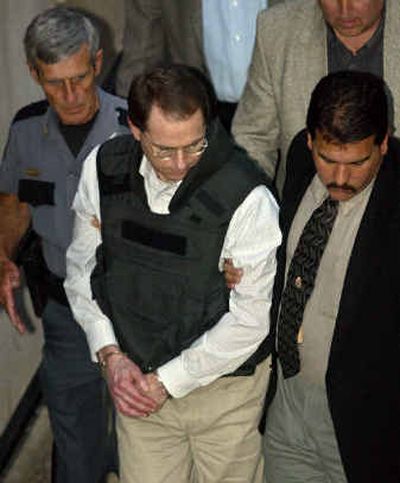Nichols escapes death

McALESTER, Okla. – Oklahoma City bombing conspirator Terry Nichols was again spared the death penalty Friday when jurors who convicted him of 161 state murder counts deadlocked over his sentence, six years after a federal jury reached a similar impasse.
The hung jury denies prosecutors the death sentence they first demanded nearly a decade ago while the bodies were still being pulled from the twisted ruins of the Alfred P. Murrah Federal Building.
Jurors announced they could not reach a verdict after deliberating for about 19 1/2 hours over three days. Nichols will be sentenced by Judge Steven Taylor, who is required by law to sentence Nichols to life in prison.
Taylor asked jury foreman Peter Mills if more deliberations could bring about a decision. Mills said that would not help.
“Three days you have worked on this,” Taylor told the jury. “And sometimes this is how cases end. The law anticipates that juries may not reach unanimous conclusions.
“I don’t want any of you to leave the building tonight feeling that you have let down the system. You’ve done your job,” Taylor said. “I am very proud of you. I commend you.”
The deadlock was a blow to state prosecutors and victims’ family members who said death was the appropriate punishment for the bombing of the Oklahoma City federal building.
“I think he should die, but that’s not my decision,” said Beverly Rankin, who was injured in the bombing. “Hopefully, he’ll never step foot out free in his lifetime.
“Why did the people in the Murrah building deserve to die? They didn’t do anything. If anybody deserved to die, it was him for helping to take their lives,” Rankin said.
Bud Welch, who lost a daughter in the bombing, opposed the death penalty for Nichols and said the state trial was a waste of money.
“It’s just a shame that we’ve paid millions of dollars and spent a tremendous amount of emotions and revictimized family members to go through this process,” Welch said.
The jury, which convicted Nichols on May 26, began deliberating in the trial’s sentencing phase Wednesday, after a week of emotional testimony. Nichols, 49, faced sentences of life in prison or death by injection.
Taylor set the sentencing for Aug. 9.
The April 19, 1995, bombing killed 168 people and wounded 500. Timothy McVeigh, Nichols’ former Army buddy and the mastermind of the bombing, was convicted of federal charges and executed in 2001 for what was the deadliest terrorist attack on American soil at the time.
In a federal trial in the late 1990s, Nichols was acquitted of murder but convicted of conspiracy and involuntary manslaughter in the deaths of eight government agents. Oklahoma prosecutors then brought him to trial for the deaths of the other victims, including one fetus, with hopes of winning a death sentence.
Prosecutors said the blast was a twisted attempt to avenge the deaths of about 80 people who died in the government siege at the Branch Davidian compound in Waco, Texas, exactly two years earlier.
They said Nichols helped build the two-ton bomb – made from farm fertilizer and fuel oil – that was packed into a Ryder truck and detonated outside the federal building.
During closing arguments in the sentencing phase, prosecutor Suzanne Lister called the bombing “one of the darkest, ugliest days in American history.”
“Think about the number of dreams, the number of plans and the number of loved ones that Terry Nichols destroyed on April 19, 1995,” Lister said. “Think of them as individual human beings. One-hundred-sixty-one. Nineteen children. Some of their bodies are torn beyond recognition. Some are decapitated.”
Defense attorneys argued Nichols found God in the past four years and has corresponded with prayer partners and made cards for his children. They showed jurors childhood photos of Nichols feeding his pets and clowning with his brothers and sisters.
Just before the start of deliberations, defense attorney Creekmore Wallace stood behind Nichols, put his hands on his shoulders and asked jurors to spare his life.
“This case is about one person, this man, Terry Lynn Nichols, and whether you will take his life,” Wallace said. “It’s about whether you will kill Terry Lynn Nichols, the man.”
All 12 jurors needed to agree to a death sentence for Nichols to be condemned. The U.S. Supreme Court ruled in 2002 that only a jury – not a judge – can impose a death sentence on a murder defendant.
Prosecutors put on 65 witnesses during the sentencing phase, including bombing survivors and victims’ relatives. The defense called several Nichols family members in arguing that he deserves a chance for redemption.
Nichols was home in Herington, Kan., the day of the bombing. But prosecutors presented a mountain of circumstantial evidence that Nichols and McVeigh worked side-by-side to carry out the attack. They said Nichols bought the fertilizer, stole detonation cord, blasting caps and other materials, and helped finance the plot by robbing a gun dealer.
Defense attorneys maintained that Nichols was the fall guy for a shadowy conspiracy far wider than the government has acknowledged.
Nichols surrendered two days after the bombing – the same day President Clinton vowed: “Justice for these killers will be certain, swift and severe. We will find them, we will convict them, and we will seek the death penalty against them.”
Nichols was first brought to trial in federal court in 1997. He was sentenced to life in prison in 1998 after the jury deadlocked on a death sentence.
In 1999, Oklahoma prosecutors charged Nichols with murder with the goal of getting a death sentence against Nichols.